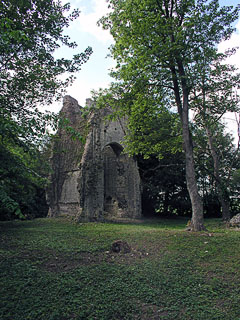In a clearing in a wood, there stands a tower. This is a haunting place. The village of Silverley was mentioned at Domesday, and the earliest mention of a church here was in 1177. Since then, though there has been a long, slow dying of the village. In 1554 the parish was merged with neighbouring Ashley, and the last request for burial here was in 1564. The village itself dwindled after that, and the local historian Paul Saunders (whose article on Silverley I have found extremely useful) notes that Silverley appears to have completely disappeared between the 17th century and the 19th century. Now, nobody can even find where it was.
So, here is the sole survivor - the last memory of a vanished population. What is left of All Saints sits in a little wood, some way to the south of Ashley on the Lidgate road. As you drive past, you see glimpses of the tower through the trees, but it would be very easy to miss. We parked by an isolated cottage and wandered into the wood, scattering ghosts as the leaves crunched under our feet.
Little is left, now: the body of the church has long disappeared, so neatly that only raised bumps in the grass indicate the lines of the walls. I paced it out from west to east, and it was only 20 metres long - not a large building, at all. All that is left now, though, is the west tower. It is a glorious, strange, disturbing thing to find a ruined tower in a little wood like this. Time has ripped it open and masonry has spilled out at the base like stony viscera. Once upon a time this was a reasonably impressive structure, similar to many in the area. In another possible world, I would be writing this entry and commenting on the elegant tower arch, the nice stair turret and the solid-looking buttresses set back somewhat from the corners. To see it in this state is unsettling. The stairway has been partially ripped open, and the delicate spiral within has the beauty of polished bone. Trees grow out of the top of the tower, and the encroaching yews are gradually reducing the buttresses to dust.
It has all taken a long time, of course, and it will take a long time yet before the tower of All Saints succumbs to the wood. Decay, in churches as in human organisms, is a slow, gradual, gentle thing. Why then did images of violence spring to my mind, that sunny day in the clearing in the wood? The trees burst out of the masonry like small explosions, and the rubble at the base was obscene. It was as though a furious hand has fallen upon the tower, and pulled it open with a grimace and a yank.
I shuddered, and suggested we leave: it is not good for the living to remain in such places. And, as we walked, the ghosts (who had been hiding in the little pools of light between the green trees) flowed past us like water, ready once again to rend their lost tower and drag it with them into annihilation.
All Saints is always open.
